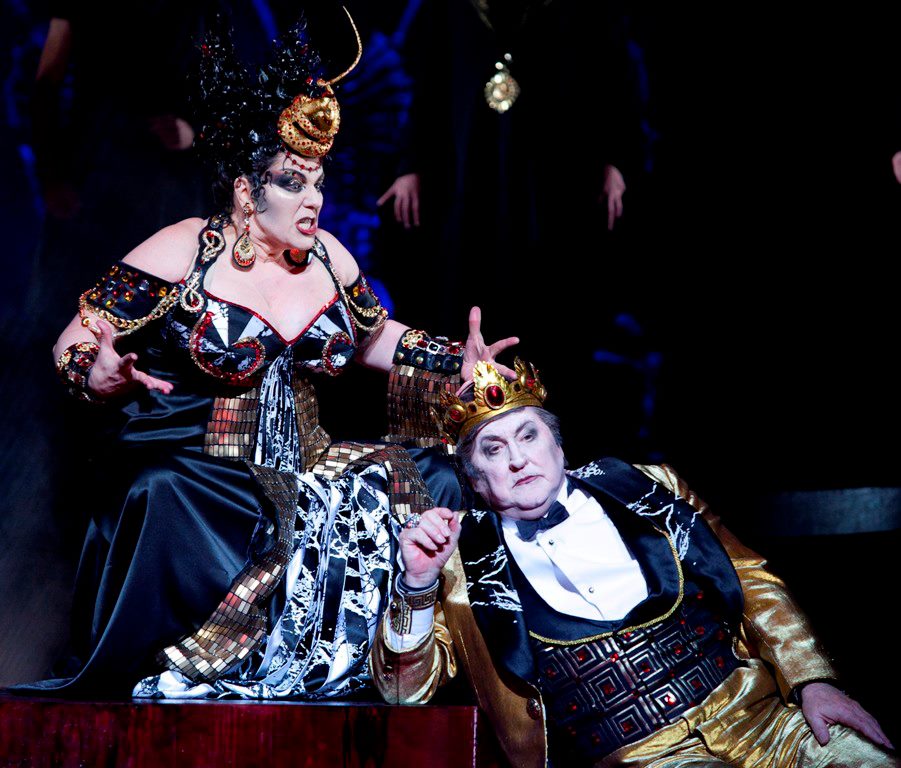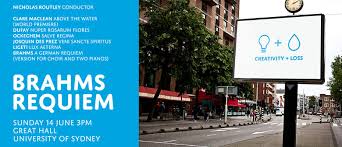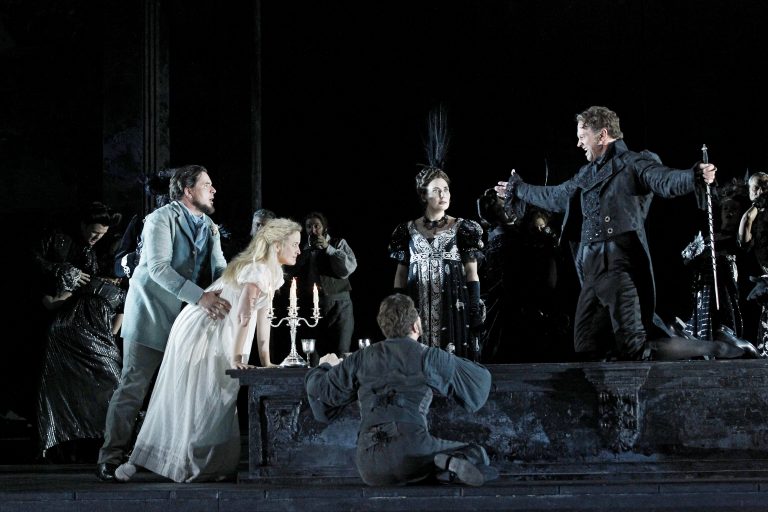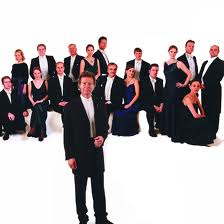Review: Das Rheingold, Opera Australia

Photo credit Jeff Busby
Opera Australia: Der Ring des Nibelungen: Das Rheingold
Arts Centre Melbourne/18 November 2013
*****
There was certainly a buzz of excited anticipation as opera lovers mingled with the glitterati for the unveiling of Opera Australia’s first Ring Cycle – the monumental work that is said to mark the coming of age of an opera company.
Any images of the staging of this production have been kept as closely guarded as Fafner’s golden hoard with one exception: the Rhine maidens. Sparkling with rhinestones and sporting Tivoli showgirl plumage, they would even outdo the bling worn by the audience. Although looking more fowl than fish, the physical charms of Lorina Gore, Jane Ede and Dominica Matthews made totally credible objects of desire. In the flesh, they proved to be equally persuasive as vocally gorgeous, playful temptresses.
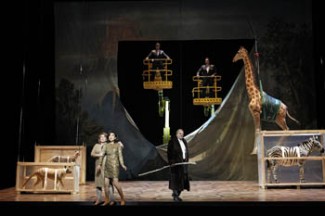
Photo credit Jeff Busby
What was not expected was the opening vision of humanity lying on a slowly revolving stage, with a giant overhanging mirror providing a bird’s eye (or perhaps god’s eye) view. Dressed in bathing costumes and coming in all shapes, sizes and ages the movements of this skillfully choreographed sea of humanity grew in intensity with Wagner’s music. From the sombre opening low E flat a rapt audience was transported into a surging Rhine. Dancers lifted the Rhine maidens joyously over the waves. Light gleamed on the gold as the bathers waved shimmering handfuls of golden tinsel, mesmerizing the Nibelung dwarf Alberich and audience alike.
Taking on the role of Alberich at short notice, Warwick Fyfe impressed both vocally and dramatically. If the honours went to any one performer on the opening night then they were his and the audience acknowledged his outstanding contributions enthusiastically. His voice has gathered power and focus over the years to become a formidable instrument, which he is able to colour to great effect. His fury at the Rhine maidens’ mockery and his eagerness to renounce love in order to forge the ring that will give him mastery over the world dripped with malevolence. His transformation from would be lover to violent despot enslaving the inhabitants of Niebelheim was remarkably convincing.
Neil Armfield’s reputation as one of Australia’s foremost theatre directors was very much in evidence in this recreation of Albrecht and in the work of the other singers. His ability to nuance the interaction between the characters and reveal their inner motivations reflected an imaginative appreciation of Wagner’s dramatic and musical intentions.
Along with an emphasis on the human dimension, Armfield’s collaboration with set designer Robert Cousins explored further parallels between Wagner’s world and a more contemporary setting. The giants Fafner and Fasolt, who had built Valhalla for Wotan, made their appearance on cherry pickers, crashing through a replica of the backdrop used for the first production of Rheingold. They are giants of the construction industry in their suits, pink ties and dark glasses. With strong, dark voices and strutting gait, Daniel Sumegi and Jud Arthur made an imposing pair. Wagner’s rejection of the excesses of the industrial revolution with its emphasis on power and wealth at the expense of nature finds expression in the giants’ acceptance of Albrecht’s hoard of gold, including the ring and the tarnhelm, as an alternative to the feminine comforts of the goddess Freia. In this production the hoard takes the form of shiny gold boxes with the inscription 4G PHONE. This turned out to be a tellingly prescient conception as the gold iPhone was coincidentally launched soon after.
In the pivotal role of Wotan, Terje Stensvold was outstanding. He has a commanding presence and a voice of great richness, power and beauty. It was immediately evident that his qualities would make the next two operas in the cycle experiences that should not be missed. Other strong performances added to the success of this production. Graeme Macfarlane’s portrayal of Mime was more vibrant and less servile and whining than is sometimes the case and Richard Berkeley-Steele gave Loge the edgy wit and vitality needed for this trickster. Deborah Humble was a rich-voiced, compelling Erda, wearing a Chanel suit and wielding a cane for the blind, whilst Jacqueline Dark was suitably forceful as Fricka.
Of course, the crucial ingredient for artistic success was the orchestra. Despite the off-stage drama surrounding the change of conductor, the choice of Pietari Inkinen has proved to be a most happy one. It has been well worth the considerable expense involved in taking out those rows of seats to accommodate the expanded orchestra, which excelled itself on opening night. Attention to fine detail and the shaping of the dynamics from barely audible to full orchestral splendour brought Wagner’s score to thrilling life.
The final scene, with its array of rainbow-coloured showgirls leading the way to Valhalla with their highly disciplined fan waving, married effectively with the depiction of the Rhine maidens. A further echo of the showgirl motif was the way the tarnhelm transformations were executed. In fact, the audience will still be pondering the mysteries of that conjuror’s trick. While there were moments when the staging was fairly minimal and others that verged on the gimmicky, ultimately the choices made by Armfield, Cousins and costume designer Alice Babidge worked.
At the end of the dress rehearsal, I had wondered whether a second viewing of this production would be less satisfying with the surprise element lacking. In fact, the reverse was the case and I was not alone in wanting to be transported yet again. The standing ovation that greeted the almost three hours of unbroken magic was richly deserved.
Melbourne Ring Orchestra/Conductor: Pietari Inkinen
Director: Neil Armfield/Set Designer: Robert Cousins/Costume Designer: Alice Babidge/Lighting Designer: Damian Cooper
CAST in order of appearance: Woglinde: Lorina Gore/ Wellgunde: Jane Ede/ Flosshilde: Dominica Matthews/
Alberich: Warwick Fyfe/ Wotan – Terje Stensvold/ Fricka: Jacqueline Dark/F reia: Hyeseoung Kwon/Fasolt: Daniel Sumegi/ Fafner: Jud Arthur/ Froh: Andrew Brunsdon/ Donner: Andrew Moran/ Loge: Richard Berkeley-Steele/ Mime: Graeme Macfarlane/ Erda: Deborah Humble
Heather Leviston for SoundsLikeSydney©
Heather Leviston has devoted much of her life to listening to classical music and attending concerts. An addiction to vocal and string music has led her to undertake extensive training in singing and perform as a member of the Victoria State Opera chorus and as a soloist with various musical organisations. As a founding academic teacher of the Victorian College of the Arts Secondary School, she has had the privilege of witnessing the progress of many talented students, keenly following their careers by attending their performances both in Australia and overseas. As a reviewer, recently for artsHub, she has been keen to bring attention to the fine music-making that is on offer in Australia, especially in the form of live performance.



